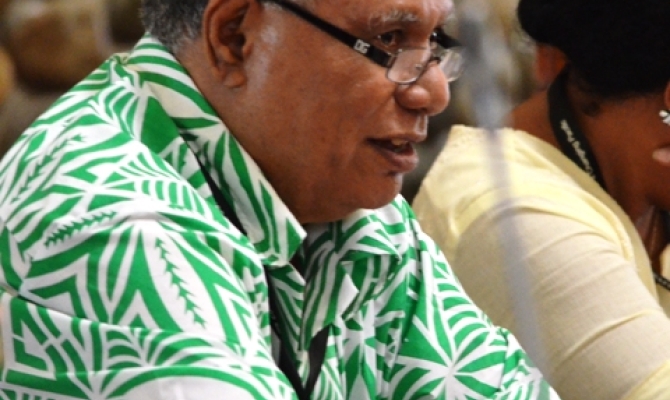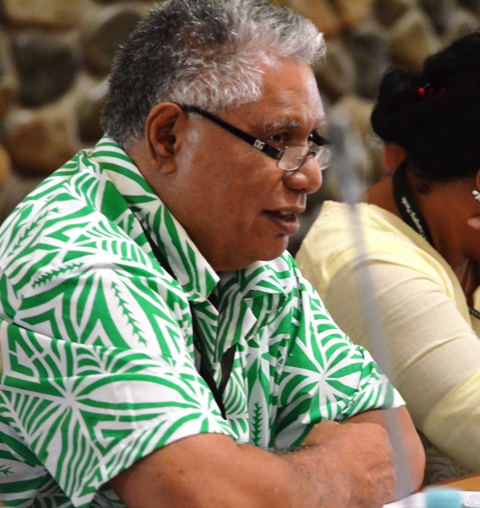
Island and Ocean Ecosystems
6 December 2013, Suva Fiji - By Priya Chand, a journalism student of USP:- Samoa has many success stories in terms of building climate resilience, says Tusani Joe Reti, a founding member of the Roundtable on Nature Conservation in the Pacific.
 Tusani Joe Reti
Tusani Joe Reti
Speaking at the 9th Pacific Islands Conference on Nature Conservation and Protected Areas, Tusani Joe said despite the focus of the 1985 conference on constraints, there were some success stories that could be learnt from.
"Organisations like SPREP, IUCN, Conservation International and TNC, to name a few, have all been very successful in their efforts to engage different sectors in the conservation movement," he said.
"There have been special training and awareness programmes conducted for the media people, the youth groups, the parliamentarians, the private sector and, of course, various agencies of governments."
Tusani Joe said regional campaigns effectively supported by national efforts had also been launched for the conservation of specific species and ecosystems over the years.
"For example, we had the Year of the Sea Turtle in 2006, the adoption of the Island Biodiversity Programme of Action during COP 8 and we had specific activities for the conservation of dugongs, whales and dolphins," he said.
"And, many Pacific Island countries have adopted the Convention on Migratory Species, the Pacific Invasive Learning Network (or PILN) and more recently the Ramsar Convention."
Tusani Joe also noted the commitment of several northern states through the Micronesian Challenge which aimed to protect 30 per cent of their near-shore and 20 per cent of their terrestrial resources by 2020.
He said efforts in recent decades have been well documented and acknowledged, and that they had put the Pacific region on par with other regions of the world that had far greater capacity and resources to achieve their conservation goals.
"But we must not stop here," he cautioned.
"There is still a long way to go yet to ensure the achievements of today are not threatened by the challenges of tomorrow.
"The successes of today should provide us the impetus and courage to continue to move forward and these are lessons we need to take forward, not stored away to be unheard of again as we confront new challenges," he said.
Priya Chand is a member of the Media Team providing coverage of the 9th Pacific Islands Conference on Nature Conservation and Protected Areas from 2 to 6 December in Suva, Fiji. This is a partnership between the Fiji National University (FNU), University of the South Pacific (USP), SPREP and Pacific Islands News Association (PINA) whereby a team of 10 journalism students are mentored by senior reporters as they cover the conference. This activity is funded by the Pacific Assistance Media Scheme (PACMAS).
 Tusani Joe Reti
Tusani Joe RetiSpeaking at the 9th Pacific Islands Conference on Nature Conservation and Protected Areas, Tusani Joe said despite the focus of the 1985 conference on constraints, there were some success stories that could be learnt from.
"Organisations like SPREP, IUCN, Conservation International and TNC, to name a few, have all been very successful in their efforts to engage different sectors in the conservation movement," he said.
"There have been special training and awareness programmes conducted for the media people, the youth groups, the parliamentarians, the private sector and, of course, various agencies of governments."
Tusani Joe said regional campaigns effectively supported by national efforts had also been launched for the conservation of specific species and ecosystems over the years.
"For example, we had the Year of the Sea Turtle in 2006, the adoption of the Island Biodiversity Programme of Action during COP 8 and we had specific activities for the conservation of dugongs, whales and dolphins," he said.
"And, many Pacific Island countries have adopted the Convention on Migratory Species, the Pacific Invasive Learning Network (or PILN) and more recently the Ramsar Convention."
Tusani Joe also noted the commitment of several northern states through the Micronesian Challenge which aimed to protect 30 per cent of their near-shore and 20 per cent of their terrestrial resources by 2020.
He said efforts in recent decades have been well documented and acknowledged, and that they had put the Pacific region on par with other regions of the world that had far greater capacity and resources to achieve their conservation goals.
"But we must not stop here," he cautioned.
"There is still a long way to go yet to ensure the achievements of today are not threatened by the challenges of tomorrow.
"The successes of today should provide us the impetus and courage to continue to move forward and these are lessons we need to take forward, not stored away to be unheard of again as we confront new challenges," he said.
Priya Chand is a member of the Media Team providing coverage of the 9th Pacific Islands Conference on Nature Conservation and Protected Areas from 2 to 6 December in Suva, Fiji. This is a partnership between the Fiji National University (FNU), University of the South Pacific (USP), SPREP and Pacific Islands News Association (PINA) whereby a team of 10 journalism students are mentored by senior reporters as they cover the conference. This activity is funded by the Pacific Assistance Media Scheme (PACMAS).